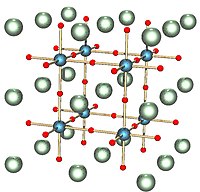
Photo from wikipedia
Abstract A novel BaTiO3/AgI heterojunction with a three-dimensional (3D) hierarchical microstructure was synthesized via a hydrothermal and in-situ co-precipitation route. As a photocatalyst, the BaTiO3/AgI heterojunction exhibited an optimal Rhodamine… Click to show full abstract
Abstract A novel BaTiO3/AgI heterojunction with a three-dimensional (3D) hierarchical microstructure was synthesized via a hydrothermal and in-situ co-precipitation route. As a photocatalyst, the BaTiO3/AgI heterojunction exhibited an optimal Rhodamine B (RhB) removal performance (92.2%) under the visible-light irradiation within 15 min, which was 82.3 and 3.7 times of the pure BaTiO3 and AgI, respectively. The superior photocatalytic activity was achieved by the considerable specific surface area of hierarchical microstructure, reinforced visible-light response ability and promoted spatial separation efficiency of photo-induced carriers by heterojunction interface. It was suggested that small amount of Ag nanoparticles reduced in-situ on the BaTiO3/AgI heterojunction surface during the photocatalytic reaction process could act as an electronic transfer medium for promoting the photo-induced electrons on conduction band (ECB) of AgI. Therefore, a typical spatial charge transfer mechanism of the BaTiO3/AgI heterojunction was proposed. Moreover, this current work can significantly provide a new insight of the BaTiO3-based photocatalysts for the efficient environmental governance and energy utilization.
Journal Title: Ceramics International
Year Published: 2021
Link to full text (if available)
Share on Social Media: Sign Up to like & get
recommendations!